Keith Fitton
KEITH ALEXANDER FITTON

Keith Alexander Fitton was born 2nd October 1916 at home in Derby Street, Kogarah. He was the youngest of three children, a much loved member of a loving family and, if you listened to his siblings, probably the favourite. Those who knew him noted that he was gentlemanly, a stylish dresser and just a lovely man.
After attending Kogarah Primary School and Hurstville Technical College, he went to work doing various unskilled jobs. Whilst employed with Max Factor, Keith completed a Bookkeeping Course and received a Diploma from the Metropolitan Business College.
He began Flying Training with Kingsford Smith Air Service Ltd on 10th March 1935 where one of his instructors was Tommy Pethybridge. Also flying at Mascot was Harry Birley. Harry had a lovely younger sister, Jean, who fell for Keith (or vice versa) and they eventually married. Keith made his last civil flight just before the birth of their son, by which time he had logged a total of 30 hours in De Havilland Moth, Avro Avian and De Havilland Tiger Moth aircraft.
Keith joined the RAAF Reserve on 29th July 1940 and then enlisted on 3rd March 1941. By this time his sister’s husband, Bert Landale, had joined the AMF and would become a Rat of Tobruk; he was awarded Mentioned in Dispatches. Harry Birley was in the RAAF; he flew in 13 & 100 Squadrons and attained the rank of Squadron Leader by War’s end .
During initial training at Mascot, Keith was involved in a photo shoot for PIX Magazine and an article was published on 12th July 1941 under the title “From Book-keeper to Fighter Pilot”. One image showed Keith looking at a waitress who was handing him some biscuits. The photographer asked him to smile at the waitress and Keith replied that he would have to smile at the biscuits or his wife would kill him.
Keith’s Service Diary indicates that most trainees were on ‘tenterhooks’ towards the end of the Initial Training School, wondering if they would be selected as pilots, observers or W/T gunners. Most (99%) wanted to be pilots but Keith assumed that only 50% would get their wish. On Friday morning, 28th March, during this ITS at Bradfield Park, Keith was among more than 1000 air crew trainees and reservists who marched through the streets of Sydney to the Town Hall where the Governor, Lord Wakehurst, took the salute. It was the first complete RAAF march ever held in Sydney.
In May/June 1941, whilst undergoing Elementary Flying Training, Keith flew past his family who were waiting on the shore of Botany Bay near Ramsgate baths. On another occasion he flew along Hastings Road, Kogarah, where his parents lived. Keith Jnr also has a memory of his father and a mate practising Morse Code with a fork on the kitchen table.
Keith then completed two courses at 2 SFTS Wagga. The first with the Intermediate Training Squadron (12 Course) and the second with the Advanced Training Squadron which ended in October 1941. The next part of his training would be with Central Flying School at Camden between late October 1941 and early February 1942. On 29th October, Keith wrote that he had been allotted to Instructor P/O Lavers (Justyn Ronald Lavers – 03387). He had his first flight in the Wackett Trainer which they called “cacs” and he noted that cockpit drill was identical to the Wirraway. Though he would be there for fourteen weeks, accommodation was scarce and it was unlikely that Jeannie & Keith Jnr could be housed. On completion of the Service Flying Instructor Course at Central Flying School Camden in January 1942, Keith was posted to 2 SFTS (Wagga Wagga) then 5 SFTS (Uranquinty).
Until 30th April 1943, Keith lived at Fitzharding Street, Wagga Wagga, with his wife and son and must have had some time for recreation because at this time he had the reputation of being the best shot in the Riverina. There are photographs of the family at the Brunskill’s property and it is believed that servicemen were entertained there from time to time.
Another story from this period concerns the wives and children who would sometimes gather at the river for swimming and a picnic. Keith was interested in the whereabouts of this gathering, which information Jeannie innocently provided. Not long afterwards, several low flying Wirraways shattered the tranquility of the scene.
It was at Wagga Wagga that Keith reached a total of 1000 flying hours so the stiffening was taken out of his hat and his wife shaped it with bobby pins to get the ‘thousand hour bash’. Keith’s sister, Jean, said that he spoke about being a pig farmer and he did attend the Wagga Wagga pig sales. However, Jean thought it likely that he would have stayed in the RAAF where he was known for his flying ability.
Keith Jnr was told by his mother that pilots were always having forced landings in Wirraways but they only counted the ones that landed away from the strip. One of these ‘away’ forced landings was at Wiralla Station (870kms west of Brisbane) on 16th December 1942, when Keith and W/O Rankin were delivering Wirraway A20-409 from Uranquinty to Townsville. Keith reportedly stayed for a dance that night and his log book shows that he collected W/O Rankin from Cunnamulla Aerodrome on 20th and continued the flight to Townsville where they arrived the same day. Total flight time Uranquinty to Townsville was 11¼ hours. On the 22nd Keith had 30 minutes dual flying in Short Empire Flying Boat VH-ABG with Captain R. B. Tapp, before flying as passenger in the same aircraft for the 10½ hour flight to Sydney non-stop.
In 1943 Keith requested posting to an operational unit. When his father asked why he had volunteered for ‘front line duty’, he said that he would rather fight the enemy on their ground than ours. On leaving 5SFTS on 30th April 1943, Keith’s Service flying amounted to 1015 hours 10 minutes and his flying ability was assessed as ‘Above Average’. By 1st May 1943 Keith had transferred to 4 OTU at Williamtown and training included No. 1 Vengeance Course. He also flew a Spitfire MkV, an Anson, a Tiger Moth and a Piper Cub and carried out one each Army and Naval co-operation flights. Between 18th December and 11th January he was at Tocumwal on a Beaufort course in 5 OTU; and this was followed by Beaufighter training in No. 14 Course between 17th January and 11th February. On this Course he met Allan Cobb a Pilot and Sydney Green a Navigator, and they became good friends.
On completion of the Beaufighter Course, Keith was assessed as a “sound pilot who should develop into a useful flight leader in an operational Squadron”.
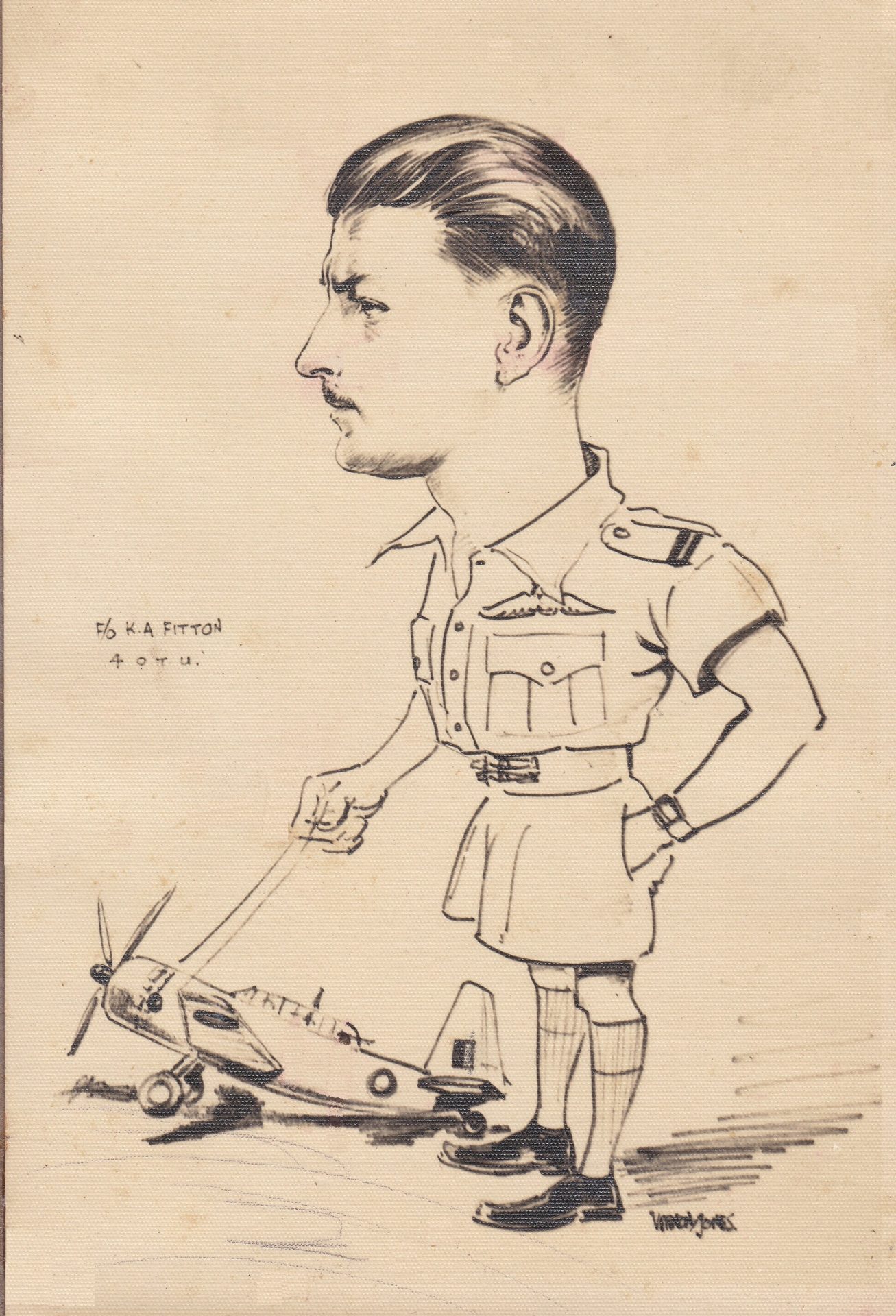
(It is also worthy of mention that CO of 5 OTU at the time was Brian ‘Black Jack’ Walker who, a quarter of a century later, would mentor Keith Jnr and, later still, participate in Keith Jnr’s Aerial Display company. In 1996, Keith Jnr’s son became a pilot and Black Jack’s bond with the family was further cemented when he was invited to present Michael with his wings at Coffs Harbour Aero Club. In 2001 Michael, as Chief Pilot of a Wyndham aviation company, regularly flew into Kolumburu Mission, landing on the Drysdale airstrip.)
On Monday 21st February 1944 Keith farewelled his family when he was posted to 55 OBU in Gorrie, WA. By the following Thursday he, Allan and Syd were in Adelaide, SA.
On Sunday 27th they left Parafield aerodrome at 0730 in a C.47 Transport on their way to 31 Squadron. Nineteen others were on board, including five Americans. The aircraft took them to Bachelor via Oodnadatta, Alice Springs and Geraldton; and they then travelled by truck to Coomalie. Keith remarked in a letter that he was thankful they flew because the overland trip would have taken about five days through “the most desolate country one could possibly imagine”. At Coomalie Keith, Allan and Syd set about erecting their tent and scrounging useful items. They cut bamboo for the framework and also used it, with boxes and fibrolite, to make a dressing table. Mention was made that they had electric light. Mention was also made that they had seen crocodile tracks down at the creek.
By 5th March, Keith still had not flown and was waiting for his Nav., Raymond Foyle, whose arrival had been delayed due to his having to attend a Court Martial at Tocumwal (as a witness).
Between 10th and 23rd March, Keith was involved in the Squadron move to Exmouth Gulf (Potshot) and the collection of four replacement Beaufighters from Kalgoorlie.
The Squadron returned to Coomalie on 23rd March. By 26th March Raymond Foyle had arrived at Coomalie and he and Keith carried out a three hour familiarisation flight. The following day, in the evening, six Beaufighters were flown to Drysdale in preparation for an attack on shipping and enemy activity at Roti Island, Timor. They were to take off at first light for the target area of Pepela Bay – Oenggae Bay – Baa – Kodi Is. – Noese Is. – Nembrala – Dana Is. and return to Drysdale.
On 28th Keith Fitton and Raymond Foyle were flying in Beaufighter A19-182. While making a second strafing run on a beached prahu at the head of Pepela Bay, their aircraft was seen to hit the mast of the prahu with the port wing about five feet from the wingtip. The aircraft climbed steeply to 200 feet when it turned over on its back, stalled and went into a vertical dive. The aircraft exploded and burst into flame on impact with the ground about 150 yards inshore. The crew were considered to have had no possible chance of escape and code books and secret wireless equipment would have been completely destroyed in the intense fire which followed the crash. Even with this knowledge, in following days squadron members did an aerial check at an escape spot on the south coast of Timor which had rations cached for emergencies. Bill Rinkin remembered they used to go home via this place on subsequent raids in the hope that they might see survivors waiting to be rescued.
Keith’s family remembered the period from March 1944 until after War’s end as being a bad time. Even though other families had losses, they were unable to mourn Keith because he was posted as “missing”. As well, an image of Keith, taken for PIX magazine, was used in ICI and recruitment advertisements which were still being published in July 1944.
Cyril Reed, a former Royal Navy Lieutenant, lived near Keith’s parents in Hastings Road, Kogarah. Cyril had joined the RAN in the 1920s and at the end of the War was serving on HMAS Kangaroo which voyaged to Timor for the Surrender Ceremony in September 1945.
He visited the Island of Roti, took a piece of aluminium from the wreckage of Keith’s Beaufighter and cut a piece from a nearby tree. He fashioned the aluminium into the shape of Roti Island, fixed it to the tree part and gave this to Keith Jnr.
In November 1945 the family was advised that the bodies of Keith and Raymond Foyle had been recovered and transferred to the War Cemetery in Koepang. An English-speaking Rotinese native, Andreas Tolle, had buried the men beside the aircraft, formed a mound of coral over it and kept fresh flowers on it. The RAAF recovery team received from Andreas, then 26 years old, Keith’s gold signet ring which he had kept hidden from the Japanese.
The following year, a Chinese businessman, Mr T. K. Lim, offered freehold of the beautiful Empire War Cemetery to the Australian Government. This cemetery overlooked Ambon Harbour. In a letter dated 1st October 1946, the family was notified that Keith’s remains had been reburied in the Galala War Cemetery, Ambon Island.
Documents held by KAFitton Jnr. (relative to Keith Alexander Fitton’s RAAF Service)
Certificate of appointment as an Officer in Citizen Air Force.
KAF Snr Service Diary
RAAF Pilot’s Training Card
Pix Magazine Article
Women’s Weekly magazine (advertisement on back cover)
Various original letters:
RAAF Ministry
W/C F.W.B. (Bill) Mann (CO 31 Sqdn)
Andreas Toelle
KAF Snr
Charles Foyle (father of Raymond Foyle)
Telegram – “Missing presumed killed”
Newspaper clippings of Death Notice and KIA Lists.
Cartoon from 4OTU 1943 – by ? Jones
The story of a brief friendship in WWII
Allies & Aviators
FITTON & VAUGHTER

Keith A. FITTON
Born 1916 – NSW, Australia
Flight Lieutenant RAAF (KIA)

David C. VAUGHTER
Born 1921 – New Mexico, USA
Captain USAAF (Ret.)
This document has been assembled by Diane Fitton using information from various sources, including the following:
Keith Anthony Fitton
Beaufighters in the Pacific (N.M. Parnell)
Australia in the War of 1939-1945 (George Odgers)
31 Squadron Narrative
Ian Wickens, Ian Cobb (son of Allan Cobb) and Fred Anderson
OZATWAR Website and Peter Dunn
© Diane Fitton – 2012
The Search for Lt Vaughter
Late in 2011, Keith & Diane Fitton began looking into the flying history and service record of Keith’s father, Keith Alexander Fitton. On the last page of his Log Book, Keith Jnr noticed a flight conducted in a C-47, registered VH-CFL, with a ‘Lt Vaughter’. Keith Jnr thought that this had to be a US Air Force Pilot and wondered why he was flying an Australian registered aircraft on a wartime mission in north western Australia. Then, in the book Beaufighters in the Pacific, Keith Jnr read a passage which mentioned “a distinguished Yank Pilot, formerly on Moresby Bully Beef transports”. This had to be our ‘Lt Vaughter’ and so a search began.
‘Vaughter’ was an unusual name but the quest turned out to be anything but simple. There were many Vaughters in various records (Social Security, Military Enlistment Papers, Obituaries, etc) but without a given name the search was almost impossible. One Lt James Victor Vaughter looked promising but he had flown only in Europe and was a POW at the time of this flight.
On 23rd February 2012, after months of searching and many dead ends, an Internet listing was found for VH-CFL. This showed that the aircraft had arrived at Amberley on 11th November 1943 for use by the 5th Air Force; and that it was operated by 21st Troop Carrier Squadron. A search for that Squadron turned up the OZATWAR website. In order to narrow down the search on this comprehensive website, an email was sent to the originator, Peter Dunn, giving him the information on Lt Vaughter and asking which squadrons would have been known as ‘Bully Beef transports’. Peter replied within the week, forwarding an email that he had received from a David Vaughter in December 2009! Peter had contacted David to obtain information on the crash of a C-47 at Cooktown on 11th June 1944.
Was this our Lt Vaughter? Should we send an email? What about privacy – what if we brought back bad memories? With about one second’s thought, an email was sent to David asking if he was the pilot of VH-CFL on the Potshot-Kalgoorlie flight in March 1944. The very next day a reply was received and David was indeed the ‘distinguished Yank’ and the person named in Keith Snr’s Log Book. David remembered the flight and especially remembered flying in a Beaufighter with Keith Snr – information not included in the initial email! What a thrill!
There followed many communications and an exchange of photographs which all helped to fill a gap in the family history and to paint pictures of these two warriors.
This contact was of significance for Keith Jnr because his father was killed fifteen days after that flight from Coomalie. On 28th March, Keith Snr flew No. 2 in a flight of six Beaufighters which carried out a raid on Roti Island, Timor. It was his first sortie into enemy territory and he was piloting the aircraft he had collected from Kalgoorlie. Whilst making a second strafing run on a prahu which was beached at the head of Pepela Bay, Keith hit the mast of the lugger and crashed inverted. Crews in the formation considered that Fitton, and his Navigator Raymond Foyle, had no possible chance of survival.
For twenty months the family held out hope for Keith’s survival despite receiving several communications stating that he had almost certainly been killed in the crash. In November 1945 a RAAF Search Party recovered the remains of Fitton and Foyle from Pepela Bay where they had been buried by a young English-speaking Christian Rotinese native, Andreas Toelle. It was at this time that Keith Jnr was told his father would not be coming home.
31 Squadron & the March 1944 emergency
Keith Snr had arrived at Coomalie Creek in the Northern Territory on 28th February and on 9th March normal operations were interrupted by the arrival of several Japanese aircraft carriers at Singapore.
The whole of 31 Squadron (124 personnel) moved to Potshot in nine Dakotas and fourteen Beaufighters.
Fred Anderson, Navigator for J.A.P. (Pat) Boyd, kept a diary and noted that some of the Squadron flew to Exmouth Gulf (Potshot) on 10th March.
David Vaughter, in VH-CFL, with Keith Fitton and other Beaufighter crews on board, flew to Potshot on Sunday 12th March. David remembers the flight well due partly to the bad weather at the time. Their alternate airport at Onslow was under eighteen inches of water and that left Potshot as the only airport within fuel range. David remarked “we were just lucky to be able to find the phone/power lines between the station and Potshot”. They encountered typhoon winds of 65mph (57kts) with gusts to 90mph (78kts) on landing.
The Australian Group Captain in charge of the operation told David that they were in urgent need of replacement aircraft which were sitting at Kalgoorlie. He asked David if he would take crews down to collect them. David asked why they didn’t take one of the five other C47s that were sitting at Potshot and the boss told him that he had asked and none of them wanted to go. The boss thought that, seeing as how David had just flown through the typhoon, he might be willing to take off into it again and fly to Kalgoorlie.
The Beaufighter crews were asked if they would go with Vaughter and they replied that they would ride anywhere with him. The aircraft was supplied with enough fuel to get to Geraldton where the crews spent the remainder of the night. The next day, Monday 13th, the journey to Kalgoorlie was completed.
There were four Beaufighters awaiting collection: A19-169, A19-177, A19-181 and A19-182. Keith did a test flight on A19-181 on 13th with three crew and the following day this aircraft was flown to Potshot via Meekatharra by Pat Boyd & Fred Anderson.
On Wednesday 15th, Keith carried out a 40 hourly Test on A19-169 with Lt Vaughter listed as crew. David vividly remembers this flight as it was his first in a combat aircraft. He said that Keith let him handle the controls while they flew alongside the big water supply pipe for Kalgoorlie and Boulder; a double treat for David.
On Thursday 16th, Allan Cobb and Syd Green, carried out a flight test on A19-177. (These two gents were close friends of Keith Snr and were greatly affected by his loss)
On Saturday 18th, two Beaufighters flew from Kalgoorlie to Geraldton where they overnighted before completing the trip to Potshot on the following day. Keith & Flt/Sgt Warner flew A19-182 and Allan Cobb & Syd Green flew A19-177. Keith, in a letter home, wrote that both he and Allan Cobb were happy with “their very own, personal Beaufighter”, the latest type, which was their’s to look after and do with what they liked. Keith had planned to get his own coat-of-arms painted on the nose as soon as possible.
On 23rd March all squadron personnel and aircraft left Potshot to return to Coomalie. Boyd & Anderson flew via Wyndham and arrived Coomalie at 8.30pm. Keith’s Log Book shows that he and Warner flew to Port Hedland where they overnighted, arriving at Coomalie the next day. Ian Wickens also overnighted at Port Hedland, he didn’t know why. Cobb & Green overnighted at Broome.
History of the emergency
(Extracted from Australia in the War of 1939-1945, Series Three – AIR, Vol. II Air War Against Japan 1943-1945. By George Odgers. Pp 136-138)
On Saturday, 4th March 1944, Australia’s Prime Minister Curtin cabled Churchill for an opinion on Japanese naval moves and the possibility of incursions into the Indian Ocean. The British assessment was reassuring.
However, on 7th March a US submarine which was north of Lombok Strait made radar contact with two heavy vessels. It was known that two battleships with escorting destroyers had left Singapore on 4th sailing in the direction of Surabaya. Thinking that Fremantle might be the objective, the following actions were taken.
All local defences were manned. Five submarines in Fremantle were ordered to form a patrol to seaward and all necessary steps were taken to clear the harbour by Thursday afternoon.
General Headquarters took immediate steps to send air reinforcements to the west coast, as follows:-
No. 380 Bombardment Group was to return from New Guinea to base at Fenton in NT
No. 43 Sqdn (Catalinas) was to move to Darwin
Nos 452 & 457 Sqdns (Spitfires) were sent to Perth as fighter defence squadrons
No. 18 Sqdn (Dutch – Mitchells) was sent to Potshot
No. 31 Sqdn (Beaufighters) was sent to Potshot
No. 84 Sqdn (Kittyhawks) was to move from Horn Island to Strauss to take the place of the Spitfires in defence of the NW Area
No. 120 Squadron (Dutch – Kittyhawks) would reposition from Canberra to Potshot
Each squadron was to move in two parts, the first part to consist of the aircraft with their crews and the second of maintenance men and equipment sufficient for fourteen days.
News of the emergency in WA leaked out to the public and rumours spread of a coming Japanese invasion or air raid. No. 1 Fighter Wing squadron commanders were told that a “Japanese naval task force was loose in the Indian Ocean headed in the general direction of the Perth area”.
By Friday, 10th March, the men of squadrons 18, 31, 120 (Canberra, ACT) and 84 (Horn Island, Qld) were imbued with a sense of urgency and worked feverishly all night. By dawn next day the aircraft were ready to go. Squadrons 457 and 452 took off at 8.00am and 8.30am for Derby. Due to bad weather some pilots landed at Wyndham. Twenty-four machines of 84 Squadron had to turn back and one disappeared into the sea. The coastal bases through which the squadrons were being sent did not have sufficient men or adequate refuelling equipment for the sudden demands and this imposed long delays.
Also on 10th March, the weather at Potshot was the worst possible. Severe cyclonic storms struck the area and converted the airfield into a swamp. The camp was flooded out and stores and equipment, which were dispersed in depressions, were covered with four feet of water. Aircraft wheels sank in the muddy ground.
The Dutch pilots of 120 Squadron flew their Kittyhawks across the Nullarbor Plain through Ceduna, Forrest and Kalgoorlie. At Kalgoorlie, Dakota and Kittyhawk aircraft were landing every ten minutes. (Note: Fitton, Vaughter and 31 Squadron personnel arrived Monday 13th)
By 12th March 452 & 457 Spitfire Squadrons were at Guildford ready to meet enemy raiders in the air. Together with No. 85 Squadron Boomerangs, they assumed the defence of the Perth-Fremantle area. No. 25 Squadron, flying Vengeances, was to make dive-bombing attacks if the enemy force came within 200 miles of the coast.
The whole emergency operation turned out to be abortive. The Japanese had no plan to attack in Western Australia or elsewhere in the Indian Ocean at that time.
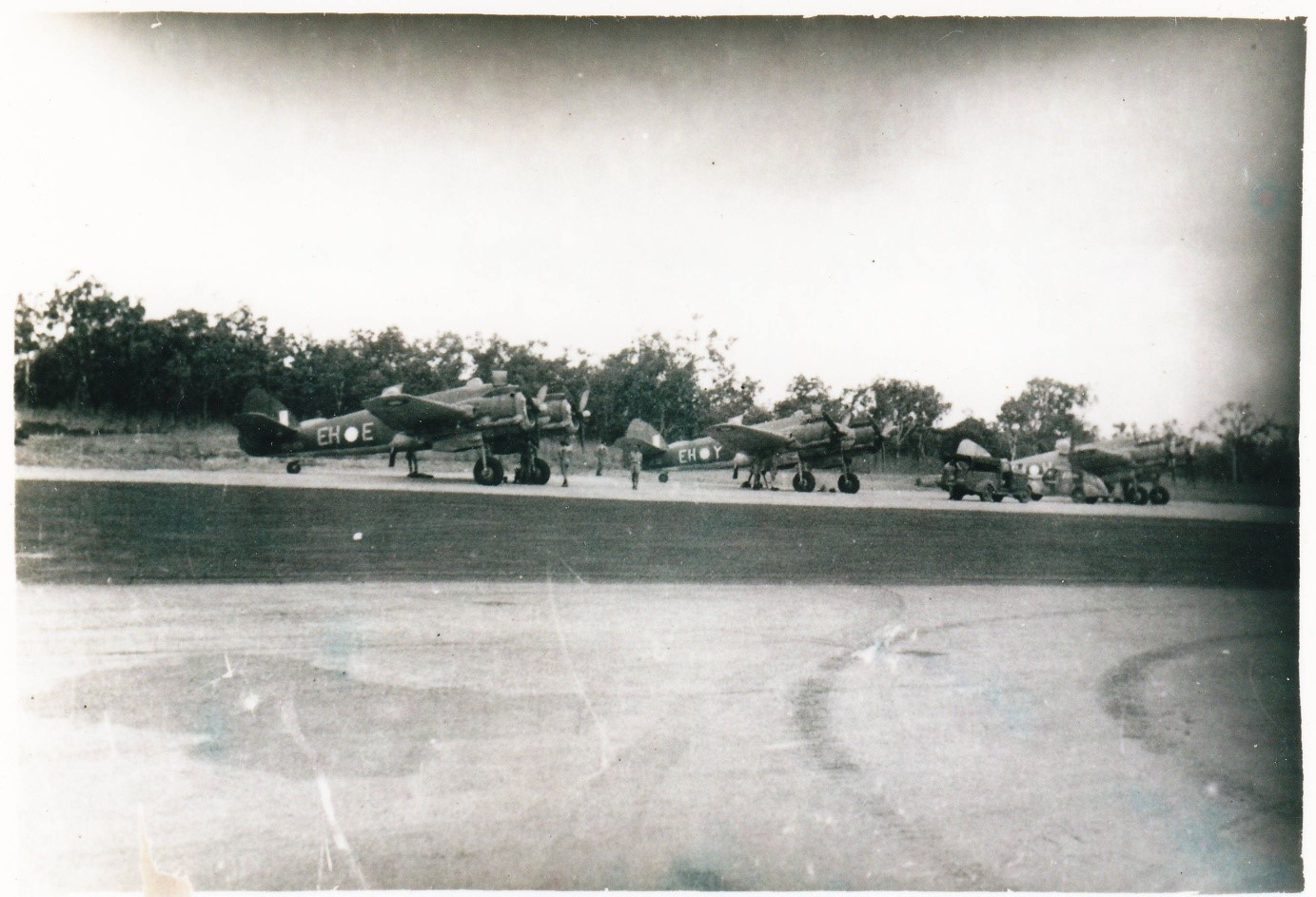
Beaufighters on Coomalie strip February 1944
(image received from Ian Wickens March 1989)

Camp site Coomalie February 1944
(image received from Ian Wickens March 1989)
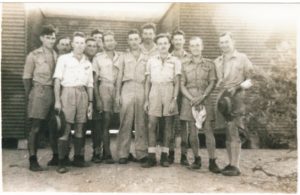
Some 31 Squadron aircrew & officers at Potshot, Exmouth Gulf, W.A.
between 9th & 24th March 1944
(image received from Ian Wickens March 1989)
Cleve Forrester (F/O), Ron Woods (Ops Officer), Syd Green (F/O), Len Mitchell (F/O),
Bob Miller (P/O), Wally McLean (P/O), John Garnham (F/O), Cyril Hansen (F/O),
Ian Wickens (F/O), Keith Fitton (Flt/Lt), Allan Cobb (F/O), Jim Moodie (Int. Officer)
In alphabetical order – Cobb, Fitton, Forrester, Garnham, Green, Hansen,
McLean, Miller, Mitchell, Moodie, Wickens, Woods)
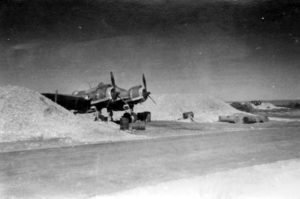
Squadron Beaufighter at Potshot March 1944
(Photograph from AWM website)
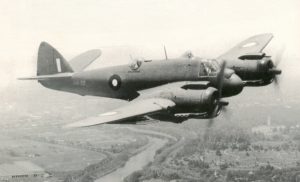
An Australian-built Beaufighter XXI over Melbourne
(From the book Beaufort, Beaufighter and Mosquito in Austalian Service by Stewart Wilson)
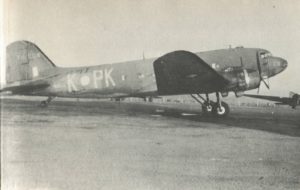
A Douglas DC3 (C-47) used for supply dropping in the forward areas
(From the book Aircraft of the RAAF 1921-71 by Pentland & Malone)
Vaughter images
(Images & Articles received by mail from David Vaughter June 2012)

Dave Vaughter in flight suit and Australian Flight Boots on wing of C-47 #57 “Yard bird” New Guinea – 1943
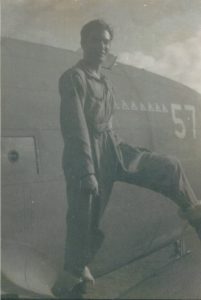
Lieutenant David Vaughter Dobodora New Guinea
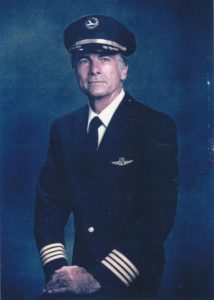
As Eastern Airlines Captain, Retired Jan 1981
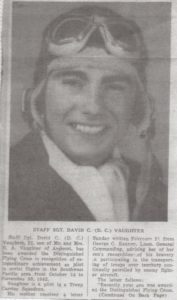
Staff Sgt. David C. (D.C.) Vaughter, 22, son of Mr & Mrs N. A. Vaughter of Amherst, has been awarded the Distinguished Flying Cross in recognition of extraordinary achievement as pilot in aerial flights in the Southwest Pacific area from October 14 to November 30, 1942. Vaughter is a pilot in a Troop Carrier Squadron.
His mother received a letter Sunday written February 21 from George C. Kenney, Lieut. General Commanding, advising her of her son’s recognition of his bravery in participating in the transporting of troops over territory continually patrolled by enemy fighter aircraft.
HERO PROMOTED and DECORATED
Special to the Star-Telegram
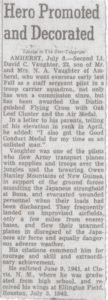
Amherst, July 8 – Second Lt. David C. Vaughter, 22, son of Mr & Mrs NA Vaughter of Amherst, who went overseas early last Fall as a staff sergeant pilot in a troop carrier squadron,
not only has won a commission since, but has been awarded the Distinguished Flying Cross with Oak Leaf Cluster and the Air Medal.
In a letter to his parents, telling of his elevation in rank in April, he added: “I also got the Good Conduct Medal for my time as an enlisted man.”
Vaughter was one of the pilots who flew Army transport planes with supplies and troops over the jungles and the towering Owen Stanley Mountains of New Guinea in support of the ground forces assaulting the Japanese stronghold at Buna, and evacuated wounded personnel when their loads had been discharged. They frequently landed on improvised airfields only a few miles from enemy bases, and flew their unarmed planes in disregard of the Japanese air force and equally dangerous adverse weather.
His citations commend him for courage and skill and extraordinary achievement.
He enlisted June 9, 1941, at Clovis, N.M., where he was graduated from high school, and received his wings at Ellington Field, Houston, July 3, 1942.
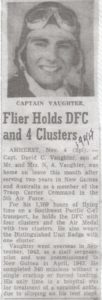
FLIER HOLDS DFC and 4 CLUSTERS
AMHERST, Nov. 4 (Spl). – Capt. David C. Vaughter, son of Mr & Mrs N.A. Vaughter, was home on leave this month after serving two years in New Guinea and Australia as a member of the Troop Carrier Command in the 5th Air Force.
For his 1789 hours of flying time on a Southwest Pacific C-47 transport, he holds the DFC with four clusters and the Air Medal with two clusters. He also wears the Distinguished Unit Badge with one cluster.
Vaughter went overseas in September 1942 as a staff sergeant pilot and was commissioned in New Guinea in April 1943. He completed 340 missions without a single crackup or forced landing. His only time in a hospital was for treatment of a sprained ankle due to slipping on his tent step.
VH-CFL – Douglas C-47-DL – C/n 6071.
| Construction completed at the Long Beach plant – November 30, 1942
Built as a Douglas C-47-DL |
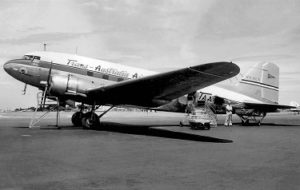
VH-AEX. Trans Australia Airlines – in the ‘silver tail’ livery at Melbourne’s Essendon Airport, date unkown
Personnel:
Anderson, Fred (Frederick Bertram Anderson (Sgt, P/O) (32784)(14 Beaufighter Course)
Boyd, Pat – JAP Boyd, Flt Lt, Sqn Ldr (400691) (14 Beaufighter Course)
Cobb, Allan Herbert – Flt Lt. (423224) (14 Beaufighter Course)
Fitton, Keith Alexander – Flt Lt. (403730) (14 Beaufighter Course)
Green, Sydney Francis – Flt Lt. (412949) (14 Beaufighter Course)
Vaughter, David C. – Captain USAAF (Ret)
Warner, George Robert – W/O (418028)
Cobb (Pilot) and Green (Navigator) placed In Memoriam notices for Keith in SMH 1946, 1947 & 1949. Fitton, Cobb & Green were on No. 14 Beaufighter Course.
The three arrived at Coomalie 27 Feb 1944.
Note: on 20th June 1941 the United States Army Air Corps (USAAC) was retitled as the United States Army Air Forces (USAAF)
